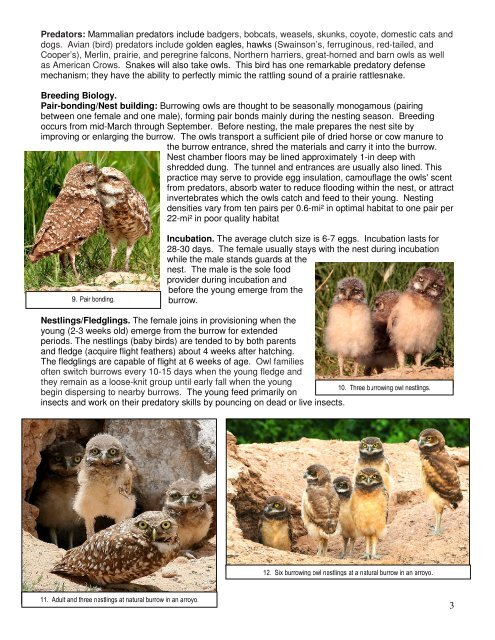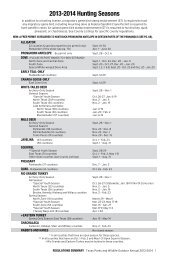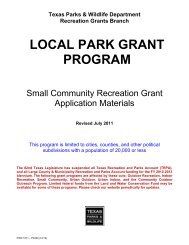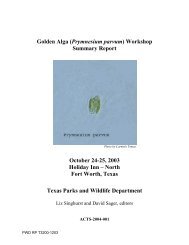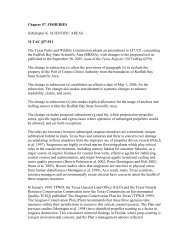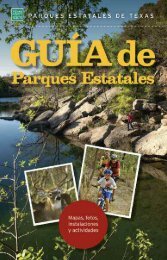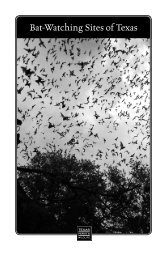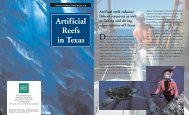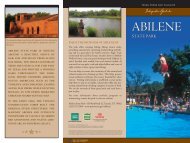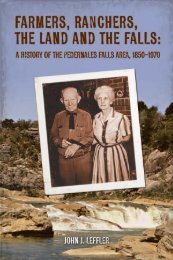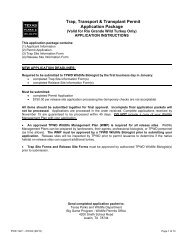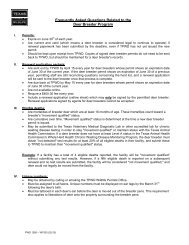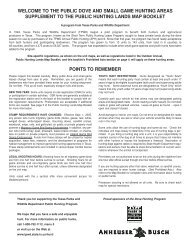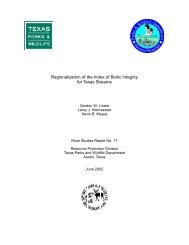1 burrowing owls of the trans-pecos and panhandle regions of texas
1 burrowing owls of the trans-pecos and panhandle regions of texas
1 burrowing owls of the trans-pecos and panhandle regions of texas
You also want an ePaper? Increase the reach of your titles
YUMPU automatically turns print PDFs into web optimized ePapers that Google loves.
Predators: Mammalian predators include badgers, bobcats, weasels, skunks, coyote, domestic cats <strong>and</strong><br />
dogs. Avian (bird) predators include golden eagles, hawks (Swainson’s, ferruginous, red-tailed, <strong>and</strong><br />
Cooper’s), Merlin, prairie, <strong>and</strong> peregrine falcons, Nor<strong>the</strong>rn harriers, great-horned <strong>and</strong> barn <strong>owls</strong> as well<br />
as American Crows. Snakes will also take <strong>owls</strong>. This bird has one remarkable predatory defense<br />
mechanism; <strong>the</strong>y have <strong>the</strong> ability to perfectly mimic <strong>the</strong> rattling sound <strong>of</strong> a prairie rattlesnake.<br />
Breeding Biology.<br />
Pair-bonding/Nest building: Burrowing <strong>owls</strong> are thought to be seasonally monogamous (pairing<br />
between one female <strong>and</strong> one male), forming pair bonds mainly during <strong>the</strong> nesting season. Breeding<br />
occurs from mid-March through September. Before nesting, <strong>the</strong> male prepares <strong>the</strong> nest site by<br />
improving or enlarging <strong>the</strong> burrow. The <strong>owls</strong> <strong>trans</strong>port a sufficient pile <strong>of</strong> dried horse or cow manure to<br />
<strong>the</strong> burrow entrance, shred <strong>the</strong> materials <strong>and</strong> carry it into <strong>the</strong> burrow.<br />
Nest chamber floors may be lined approximately 1-in deep with<br />
shredded dung. The tunnel <strong>and</strong> entrances are usually also lined. This<br />
practice may serve to provide egg insulation, camouflage <strong>the</strong> <strong>owls</strong>' scent<br />
from predators, absorb water to reduce flooding within <strong>the</strong> nest, or attract<br />
invertebrates which <strong>the</strong> <strong>owls</strong> catch <strong>and</strong> feed to <strong>the</strong>ir young. Nesting<br />
densities vary from ten pairs per 0.6-mi² in optimal habitat to one pair per<br />
22-mi² in poor quality habitat<br />
9. Pair bonding.<br />
Incubation. The average clutch size is 6-7 eggs. Incubation lasts for<br />
28-30 days. The female usually stays with <strong>the</strong> nest during incubation<br />
while <strong>the</strong> male st<strong>and</strong>s guards at <strong>the</strong><br />
nest. The male is <strong>the</strong> sole food<br />
provider during incubation <strong>and</strong><br />
before <strong>the</strong> young emerge from <strong>the</strong><br />
burrow.<br />
Nestlings/Fledglings. The female joins in provisioning when <strong>the</strong><br />
young (2-3 weeks old) emerge from <strong>the</strong> burrow for extended<br />
periods. The nestlings (baby birds) are tended to by both parents<br />
<strong>and</strong> fledge (acquire flight fea<strong>the</strong>rs) about 4 weeks after hatching.<br />
The fledglings are capable <strong>of</strong> flight at 6 weeks <strong>of</strong> age. Owl families<br />
<strong>of</strong>ten switch burrows every 10-15 days when <strong>the</strong> young fledge <strong>and</strong><br />
<strong>the</strong>y remain as a loose-knit group until early fall when <strong>the</strong> young<br />
begin dispersing to nearby burrows. The young feed primarily on<br />
insects <strong>and</strong> work on <strong>the</strong>ir predatory skills by pouncing on dead or live insects.<br />
10. Three <strong>burrowing</strong> owl nestlings.<br />
12. Six <strong>burrowing</strong> owl nestlings at a natural burrow in an arroyo.<br />
11. Adult <strong>and</strong> three nestlings at natural burrow in an arroyo.<br />
3


